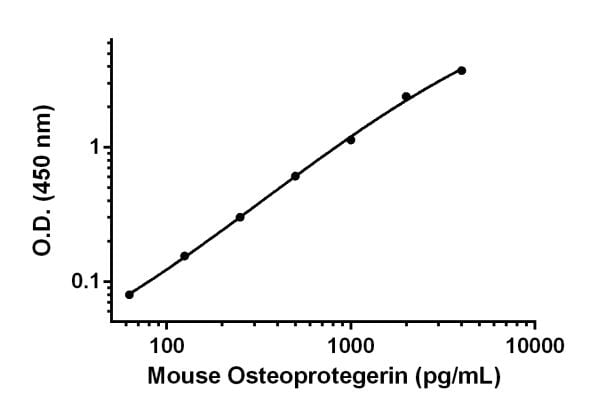Mouse Osteoprotegerin ELISA Kit (TNFRSF11B) (ab203365)
Key features and details
- One-wash 90 minute protocol
- Sensitivity: 5 pg/ml
- Range: 125 pg/ml - 8000 pg/ml
- Sample type: Cell culture supernatant, Hep Plasma, Serum
- Detection method: Colorimetric
- Assay type: Sandwich (quantitative)
- Reacts with: Mouse
Overview
-
Product name
Mouse Osteoprotegerin ELISA Kit (TNFRSF11B)
See all Osteoprotegerin kits -
Detection method
Colorimetric -
Precision
Intra-assay Sample n Mean SD CV% Serum 5 4.9% Inter-assay Sample n Mean SD CV% Serum 3 8.1% -
Sample type
Cell culture supernatant, Serum, Hep Plasma -
Assay type
Sandwich (quantitative) -
Sensitivity
5 pg/ml -
Range
125 pg/ml - 8000 pg/ml -
Recovery
Sample specific recovery Sample type Average % Range Serum 96.1 90% - 101.3% Cell culture media 104.9 102.1% - 106.3% Hep Plasma 123.4 117.9% - 132.8% -
Assay time
1h 30m -
Assay duration
One step assay -
Species reactivity
Reacts with: Mouse
Does not react with: Goat, Cow, Pig -
Product overview
Mouse Osteoprotegerin ELISA Kit (TNFRSF11B) (ab203365) is a single-wash 90 min sandwich ELISA designed for the quantitative measurement of Osteoprotegerin (TNFRSF11B) protein in cell culture supernatant, hep plasma, and serum. It uses our proprietary SimpleStep ELISA® technology. Quantitate Mouse Osteoprotegerin (TNFRSF11B) with 5 pg/ml sensitivity.
SimpleStep ELISA® technology employs capture antibodies conjugated to an affinity tag that is recognized by the monoclonal antibody used to coat our SimpleStep ELISA® plates. This approach to sandwich ELISA allows the formation of the antibody-analyte sandwich complex in a single step, significantly reducing assay time. See the SimpleStep ELISA® protocol summary in the image section for further details. Our SimpleStep ELISA® technology provides several benefits:
- Single-wash protocol reduces assay time to 90 minutes or less
- High sensitivity, specificity and reproducibility from superior antibodies
- Fully validated in biological samples
- 96-wells plate breakable into 12 x 8 wells stripsA 384-well SimpleStep ELISA® microplate (ab203359) is available to use as an alternative to the 96-well microplate provided with SimpleStep ELISA® kits.
-
Notes
Osteoprotegerin acts as decoy receptor for TNFSF11/RANKL and thereby neutralizes its function in osteoclastogenesis. Osteoprotegerin inhibits the activation of osteoclasts and promotes osteoclast apoptosis in vitro. Bone homeostasis seems to depend on the local ratio between TNFSF11 and TNFRSF11B. Osteoprotegerin may also play a role in preventing arterial calcification. Osteoprotegerin may act as decoy receptor for TNFSF10/TRAIL and protect against apoptosis. TNFSF10/TRAIL binding blocks the inhibition of osteoclastogenesis.
-
Platform
Pre-coated microplate (12 x 8 well strips)
Properties
-
Storage instructions
Store at +4°C. Please refer to protocols. -
Components 1 x 96 tests 10X Mouse Osteoprotegerin Capture Antibody 1 x 600µl 10X Mouse Osteoprotegerin Detector Antibody 1 x 600µl 10X Wash Buffer PT (ab206977) 1 x 20ml Antibody Diluent 4BI 1 x 6ml Mouse Osteoprotegerin Lyophilized Recombinant Protein 2 vials Plate Seals 1 unit Sample Diluent 50BS 1 x 20ml Sample Diluent NS (ab193972) 1 x 50ml SimpleStep Pre-Coated 96-Well Microplate (ab206978) 1 unit Stop Solution 1 x 12ml TMB Development Solution 1 x 12ml -
Research areas
-
Function
Acts as decoy receptor for RANKL and thereby neutralizes its function in osteoclastogenesis. Inhibits the activation of osteoclasts and promotes osteoclast apoptosis in vitro. Bone homeostasis seems to depend on the local RANKL/OPG ratio. May also play a role in preventing arterial calcification. May act as decoy receptor for TRAIL and protect against apoptosis. TRAIL binding blocks the inhibition of osteoclastogenesis. -
Tissue specificity
Highly expressed in adult lung, heart, kidney, liver, spleen, thymus, prostate, ovary, small intestine, thyroid, lymph node, trachea, adrenal gland, testis, and bone marrow. Detected at very low levels in brain, placenta and skeletal muscle. Highly expressed in fetal kidney, liver and lung. -
Involvement in disease
Defects in TNFRSF11B are the cause of juvenile Paget disease (JPD) [MIM:239000]; also known as hyperostosis corticalis deformans juvenilis or hereditary hyperphosphatasia or chronic congenital idiopathic hyperphosphatasia. JPD is a rare autosomal recessive osteopathy that presents in infancy or early childhood. The disorder is characterized by rapidly remodeling woven bone, osteopenia, debilitating fractures, and deformities due to a markedly accelerated rate of bone remodeling throughout the skeleton. Approximately 40 cases of JPD have been reported worldwide. Unless it is treated with drugs that block osteoclast-mediated skeletal resorption, the disease can be fatal. -
Sequence similarities
Contains 2 death domains.
Contains 4 TNFR-Cys repeats. -
Post-translational
modificationsN-glycosylated. Contains sialic acid residues.
The N-terminus is blocked. -
Cellular localization
Secreted. - Information by UniProt
-
Alternative names
- MGC29565
- OCIF
- OPG
see all -
Database links
- Entrez Gene: 18383 Mouse
- SwissProt: O08712 Mouse
- Unigene: 15383 Mouse
Images
-
SimpleStep ELISA technology allows the formation of the antibody-antigen complex in one single step, reducing assay time to 90 minutes. Add samples or standards and antibody mix to wells all at once, incubate, wash, and add your final substrate. See protocol for a detailed step-by-step guide.
-
Standard curve comparison between mouse Osteoprotegerin SimpleStep ELISA® kit and traditional ELISA kit from leading competitor. SimpleStep ELISA kit shows comparable sensitivity with shorter protocol time.
-
Background-subtracted data values (mean +/- SD) are graphed.
-
Background-subtracted data values (mean +/- SD) are graphed.
-
 Interpolated concentrations of Osteoprotegerin in mouse lung day 5 supernatant, serum and plasma (heparin) samples.
Interpolated concentrations of Osteoprotegerin in mouse lung day 5 supernatant, serum and plasma (heparin) samples.The concentrations of Osteoprotegerin were measured in duplicates, interpolated from the Osteoprotegerin standard curve and corrected for sample dilution. Note that 1X Diluted samples were neat. The interpolated, dilution factor-corrected values are plotted in pg of Osteoprotegerin per mL of neat sample (mean +/- SD, n=2).
-
To learn more about the advantages of recombinant antibodies see here.


















